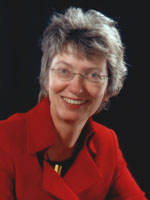
Katharina Kohse-Höinghaus
Universität Bielefeld
Waiting in Line
In the late 1970s, during my doctoral studies in chemistry at Ruhr-Universität Bochum,
I could not imagine ever attending the Gordon Research Conferences. I had friends in medicine whose professor had applied to attend a GRC oversubscribed by a factor of four and was amazed that he had to wait to hear if he would be accepted. Imagine - a well-known scientist, standing in line, waiting to be selected to attend a conference he had to pay for.
In 1983, when I was working at the German Aerospace Center, the institute director asked a senior scientist if he would recommend attending a new GRC called Laser Diagnostics in Combustion. The New Hampshire college setting did not appeal too much to my superiors, so I volunteered to try it out. I submitted a poster, which was accepted, and I attended my first GRC, the first of many in a variety of fields. A new door was opened. The authors of key articles sitting on my desk became real people within a week. Many of them are still my friends.
Since then I have been invited to speak at other Gordon Conferences, and I served as vice chair (1997) and chair (1999) for the Combustion Diagnostics GRC. The 1999 conference led me to put together a book called
Applied Combustion Dynamics, which was published in 2002. I also submitted a proposal to GRC leadership to refocus the conference in 1997, which was backed by about a hundred personal letters from participants. It was amazing to witness how readily so many scientists from different nations and age groups lent their support to this cause. This outpouring shows how unique and fitted to their respective fields Gordon Conferences are and how critical they are for scientific careers and the advancement of science.
Today I am among the “seniors” who attend the Combustion Diagnostics GRC, and I have followed the paths of more than two generations of talented students and postdocs into academic positions. Some students of my friends from 1983 are professors now whose own students attend Combustion Diagnostics, and some of my former postdocs are among today’s speakers, who in turn encourage their students to present their cutting-edge results in poster format. I have also witnessed a steady increase in the number of attendees from around the world and rising numbers of female participants from hard-core science and engineering backgrounds, as evidenced by a comparably shorter line of men for the washroom.
Speaking of washrooms, I was waiting in line for one at Boston’s Logan Airport with other GRC participants when I overheard a well-dressed woman ask another, “Do you see all of those grubby individuals? They camp out in New Hampshire for the summer and are said to be the world’s best scientists!” The college environment and a week of sleep deprivation certainly left their marks.
The Laser Combustion Diagnostics GRC was instrumental not only for the careers of those attending but also for the entire evolution of the field–from the first lasers directed into flames to novel sensors in onboard combustion diagnostics. Attending the conference every two years helped fine-tune each participant’s achievements. GRC is the only scientific conference series I know of where the discussion periods may be longer than the presentations. The conferences support and create links between people in a way that is both inviting and competitive.
Today laser methods used by combustion chemists and engineers have found their way into other disciplines, including atmospheric chemistry, materials science, and biophysics. I am confident that a new Gordon Conference inspired by these applications will surface from our progress.